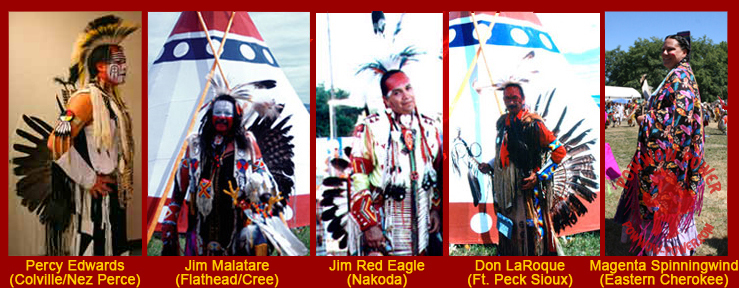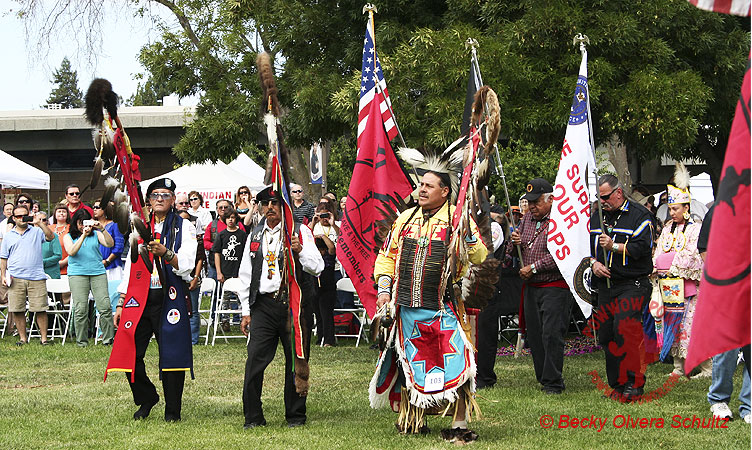Native American Powwow Dancing.
Dance regalia worn by today’s Native American dancers may reflect a particular tribe in style but many dancers’ outfits are a combination of different traditions. While some dancers may have very traditional dance regalia, many reflect the modern world’s use of sequins, synthetic fabrics and dyes, yarn and other less than traditional materials. However, whether the dance clothing is made of traditional or modern materials, the use of traditional decorative designs and symbols is still persistent (Ancona 1993:3).
Today’s Native American powwow dance activities are divided into two types, intertribal (social dances) and competition dancing. When intertribal songs are sung, all dance styles, all ages and genders participate, Indian as well as non-Indians, may enter the arbor and dance (Roberts 1992:125). A popular dance for non-Indians during an intertribal is the Round dance. It is an easy dance to follow as everyone joins hands inside the arbor forming a big circle moving clockwise. If there are many people participating, another circle is formed inside the first circle that moves in the opposite direction. The Round dance creates a simple and fun activity that brings both cultures together for positive interaction (Braine 1995:32).
Native American competition dancing became popular in the 1920’s (Campbell 1995:7). Nearly all Powwows have dance competitions with cash awards in both the men and women divisions. Dancers participating in competition pay an entry fee and wear a number on their outfits. Many dancers simply dance because they enjoy it; they dance for the people and do not participate in the competition. Money for the dance contest winners is provided by the powwow committee, but sometimes there are “specials”, which are contests sponsored by an individual or outside group (Braine 1995:19,32).
The prize money from the competition dancing is an important factor in the popularity of the powwow. A good dancer can make a reasonable living by competing nearly every weekend during peak season, if he or she is willing to travel (Parfit 1994:6,94).
Sometimes during dancing at a powwow, an eagle feather may fall off a dancer’s outfit. As soon as it is known a feather as fallen, all dancing stops, the arbor is cleared, and a special traditional ceremony is performed right then. The feather is treated like a fallen warrior whose spirit must be cared for immediately (Braine 1995:34). The ceremony is performed by four veterans who have earned the right to touch the feather–veterans who have earned honors in battle. The four veteran Native American traditional dancers perform the picking up ceremony and a veteran who has been wounded in combat is selected as the “Brave Man” to pick up the feather with another eagle feather. He then recounts a war deed or special military story of his service and then returns the feather to its owner. A gift is given by the owner of the feather to the veteran and the drum of honor for the service they have performed (Roberts 1992:5).
The highlight of the Native American powwow is the Grand Entry (opening ceremony). The dancers gather near the dance arbor entry waiting for the signal to begin the procession into the arbor. The dancers are divided into the dance categories of Traditional, Fancy, Grass (for males) and Jingle Dress, Fancy Shawl & Traditional (for females). They enter the arbor, men first, women and then the children. Grand Entrees occur usually around noon and early evenings after the dinner break. (Ancona 1993:17). All spectators stand during the Grand Entry while the host drum plays the flag song, the Indian version of the national anthem (Braine 1995:19).
When the drum selected to sing for the Grand Entry begins, the honor guards carry in the eagle staffs (spiritual staff, covered in fur and hung with eagle feathers) and flags (U.S., Canada, Mexico, various Indian Nations). The honor guards are military veterans (often dancers also). Following the veterans are any tribal officials, politicians, powwow queens or princesses and other honored guests. Next come the different categories of dancers (Braine 1995:19). All movement in the Arbor is in a clockwise direction (Ancona 1993:18-20).
At powwows, very small Indian children also dance, to the delight of everyone. They are all called into the arbor to dance at the same time. Some are so small they can barely walk! They wear smaller versions of the dance regalia and are always adorable. Most dance like mad while some are so shy and scared they end up standing in one place and crying. When the dancing is over the announcer calls them to the announcer’s booth and he hands each one money, usually a dollar bill, and tells them how good they performed (Braine 1995:30-31).
After the procession around the arbor, the eagle staffs and flags are mounted while everyone stands at attention. A special prayer and blessing is given by a selected elder and then the powwow begins (Braine 1995:20). The drum sings an intertribal song and everyone is welcome to participate in the intertribal dance following the Grand Entry (Ancona 1993:20).




